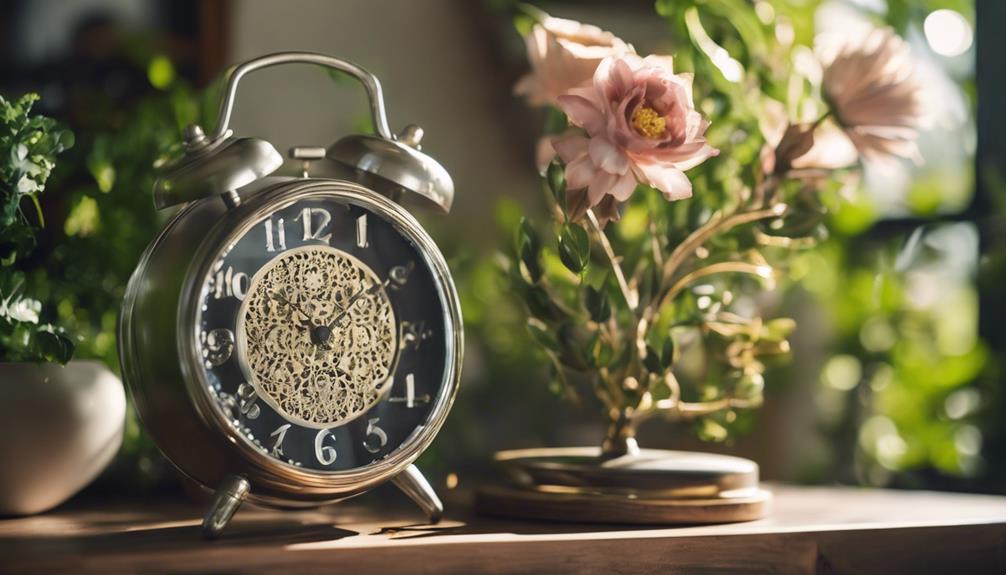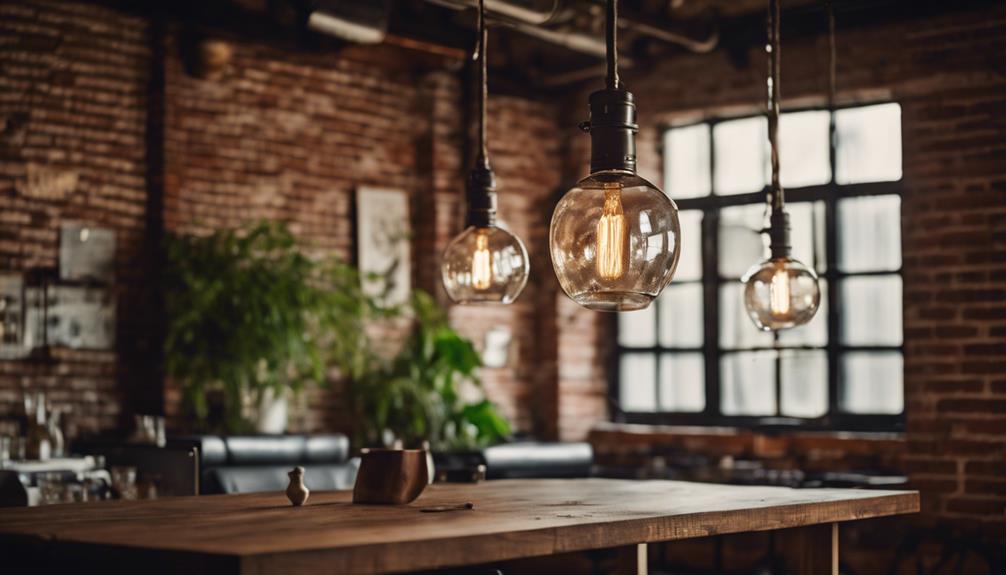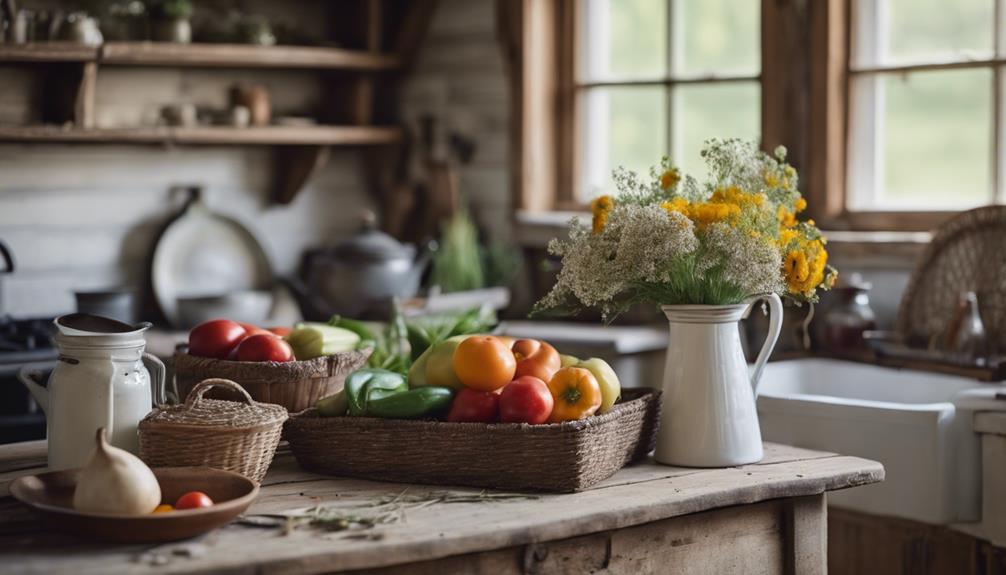Aesthetic clocks are more than just timekeepers; they're focal points that can transform your room. Whether you choose a striking black and gold design or a minimalist piece in muted tones, these clocks add character and sophistication to your decor. Vintage styles bring warmth, while modern options offer sleek elegance. Experiment with lighting to spotlight your clock, turning it into an eye-catching statement. Pair it with framed art or geometric shelves for a cohesive look. With so many designs and materials available, you can find the perfect clock to impress anyone who enters your space. Explore further for more inspiration!
Key Elements
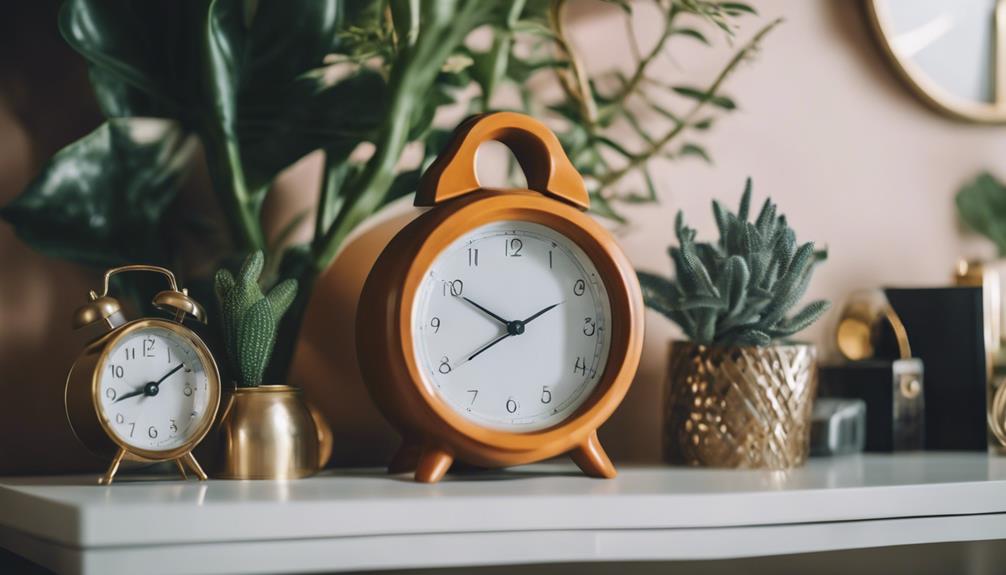
When choosing an aesthetic clock, consider the color scheme, materials, and textures that will best enhance your space.
The right combination can create a harmonious look that ties your room together.
Color Scheme
Incorporating aesthetic clocks into your room decor can greatly enhance the overall color scheme, adding both character and visual interest. A striking black and gold metallic wall clock serves as an enthralling focal point, elevating the sophistication of your space.
Large wall clocks in bold colors can breathe life into empty walls, contrasting beautifully with more neutral decor. On the other hand, minimalist wall clocks with simple designs and muted tones create aesthetic balance, blending seamlessly with existing elements.
If you're looking for warmth, vintage wall clocks with rustic finishes introduce inviting tones that complement both modern and traditional palettes.
Consider creating a collage of clocks with various colors and designs; this visually dynamic arrangement not only expresses your personal style but also harmonizes with your room's overall aesthetic.
Materials
Aesthetic clocks are crafted from a variety of high-grade materials, guaranteeing they not only stand the test of time but also enhance the visual appeal of your decor. You'll find these clocks made from durable metals, rich woods, and elegant glass, each material contributing to the overall quality and aesthetic. The meticulous craftsmanship involved assures that these timepieces aren't just functional but also beautifully designed.
Many decorative clocks feature luxurious finishes, like aged bronze or gold accents, which elevate their presence and make them true statement pieces in your space. These quality materials not only guarantee longevity but also create an inviting ambiance.
When shopping for aesthetic clocks, you'll appreciate the diverse design options available, ranging from artisan to modern styles. Customization plays a significant role in selecting the perfect clock for your home. Whether you're looking for a specific color or style to match your unique decor theme, the variety of materials and designs allows for a personalized touch.
With the right aesthetic clock, you can seamlessly blend functionality with art, making timekeeping an exquisite part of your room decor.
Textures
Textures play a significant role in the overall aesthetic of decorative clocks, enhancing visual interest and adding depth to your room's decor. When you choose a clock, consider how its textures can elevate its aesthetic charm.
For instance, vintage wall clocks often showcase intricate textures through detailed carvings, bringing character and a sense of history to modern spaces. These elements create a fascinating focal point that draws the eye.
On the other hand, modern designs may feature smooth, minimalist textures that promote a clean and organized appearance, perfect for contemporary aesthetics. The interplay of materials, like a metal clock frame combined with a glass clock face, introduces depth and dimension that enriches your room's overall ambiance.
Don't overlook the tactile quality of clock surfaces; polished surfaces can add sophistication, while matte finishes may convey warmth. By thoughtfully incorporating various textures, you can create a harmonious balance between style and function, ensuring your decorative clock not only tells time but also reflects your unique taste.
Essential Fixtures and Furniture
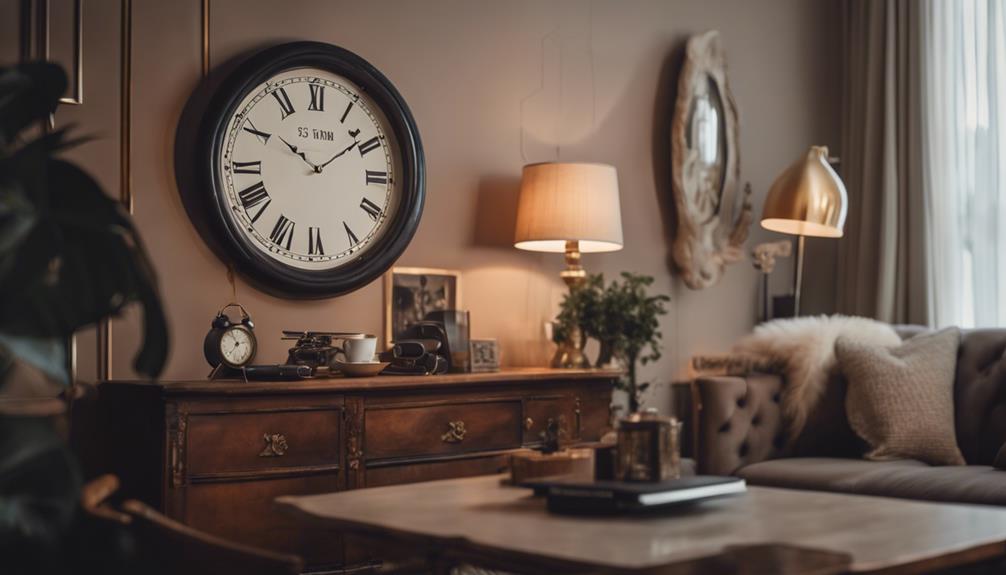
When choosing aesthetic clocks, consider pieces like the Artisan 16 Wall Clock, Finley Glass Analog Clock, and Vintage Floral Wall Clock.
Each of these fixtures not only tells time but also enhances your room's overall style.
Artisan 16 Wall Clock
The Artisan 16 Wall Clock brings a touch of mission style to your space, combining elegance with practicality. This clock features an arts and crafts element that enhances your home decor, making it a perfect fit for any room. With a striking focal point measuring 16 inches wide, it captures attention while serving a functional purpose.
Constructed with a durable metal frame, the Artisan 16 Wall Clock guarantees longevity and reliability, so you won't have to worry about replacing it anytime soon. Its battery-powered mechanism provides convenience, eliminating the hassle of cords and allowing you to place it anywhere you desire.
This clock isn't just about telling time; it's an elegant addition that complements your aesthetic, balancing form and function seamlessly. Whether you hang it in your living room, kitchen, or office, it effortlessly elevates the ambiance of your space.
With its affordable price of $96 and free shipping, you can enhance your decor without breaking the bank. The Artisan 16 Wall Clock is a timeless choice that impresses everyone while keeping your home stylish and organized.
Finley Glass Analog Clock
Building on the theme of functional yet stylish decor, the Finley Glass Analog Clock adds a modern touch with its 3D markers and elegant design. Priced at just $68, it offers an affordable way to enhance your home decor while ensuring a blend of aesthetic appeal and functionality. This clock isn't just about telling time; it's a decorative accent that elevates any room you place it in.
Constructed from high-quality materials, the Finley Glass Analog Clock is durable, promising longevity alongside its visual charm. Its unique design makes it a versatile addition, seamlessly fitting into various decor styles, from modern to minimalist.
Whether you're sprucing up your living area, bedroom, or office, this clock stands out as a chic centerpiece. You'll appreciate how the Finley Glass Analog Clock serves both as a functional timepiece and an eye-catching decor element.
With its elegant appearance and practical use, it's the perfect choice for anyone looking to enhance their space without compromising on style. Don't miss out on adding this stylish piece to your home!
Vintage Floral Wall Clock
Embracing a vintage floral wall clock can instantly transform your space, infusing it with elegance and charm while serving as a functional timepiece. These clocks boast a classic design that features intricate floral patterns, making them an enchanting focal point in any room. Crafted with high-quality materials, each vintage floral wall clock showcases detailed craftsmanship that reflects the beauty of vintage artistry.
Available in various sizes, you can easily find one that fits perfectly in your living room, dining area, or bedroom. The colorful floral motifs enhance the aesthetic appeal, seamlessly complementing an array of interior styles—from rustic to contemporary. With their nostalgic flair, these clocks not only tell time but also create a cozy atmosphere, inviting warmth into your home.
When you choose a vintage floral wall clock, you're not just adding a timepiece; you're infusing your decor with personality and charm. This timeless addition will certainly impress everyone who enters your space, making it a delightful conversation starter.
Lighting Ideas
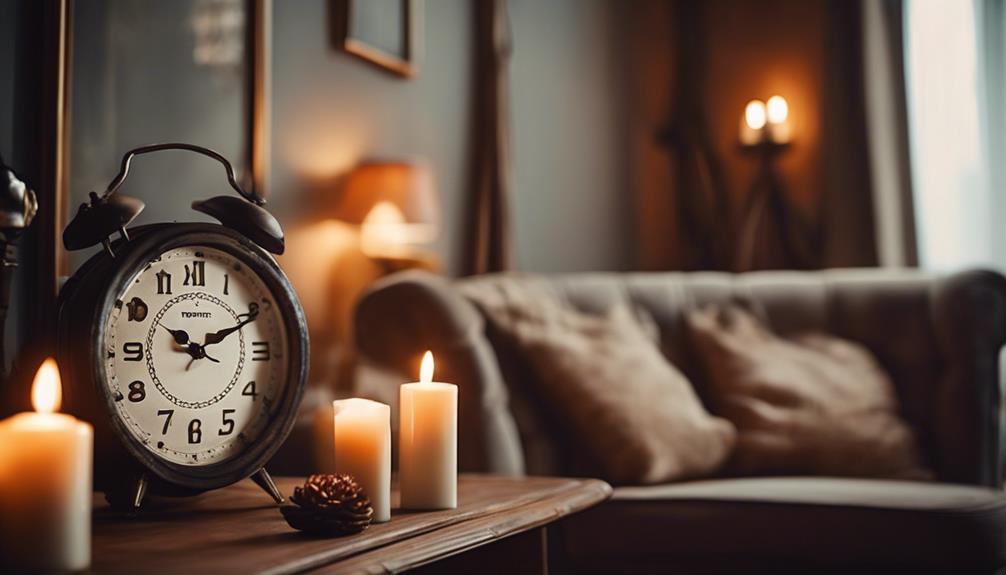
When you think about lighting ideas for your wall clocks, consider chic pendant lights hanging above them to create a stylish accent.
Sconce lighting can also enhance the clock's presence, while recessed ceiling lights can draw attention to its design.
Adding ambient LED strip lighting around the clock can further elevate its aesthetic appeal in any room.
Chic Pendant Lights Above Clock
How can chic pendant lights elevate the aesthetic of your wall clock, turning it into a stunning focal point in your room? When you hang these lights above your wall clock, they enhance its visual appeal, transforming it into a mesmerizing centerpiece.
By choosing pendant lights with unique shapes or artistic designs, you can infuse a modern decor twist that complements the clock's style, whether it's classic or contemporary. Varying the heights of the pendant lights creates dynamic layers of light and shadow, emphasizing the clock's craftsmanship while adding depth to your space.
Opt for colors or metallic finishes that harmonize with your clock—gold or black can elevate the elegance of the room. Additionally, using dimmable pendant lights allows you to adjust the ambiance, making your clock shine in the evening while maintaining a cozy atmosphere.
Incorporating these chic pendant lights not only highlights your wall clock but also creates a sophisticated setup that impresses everyone. With the right lighting, your clock becomes more than just a timepiece; it turns into an elegant statement that enhances the overall decor of your room.
Sconce Lighting for Wall Clocks
Sconce lighting often adds a touch of elegance to wall clocks, making them stand out as enchanting focal points in your room. By strategically placing sconces on either side of the clock, you can beautifully accentuate its design, transforming the entire wall into a striking feature. This approach not only enhances the visual appeal of your wall clock but also creates a warm ambiance that invites admiration.
Using dimmable sconces allows for adjustable lighting, letting you set the mood according to the occasion. Whether you're looking for a cozy atmosphere for relaxation or brighter lighting for activities, the right sconces can complement your wall clock perfectly.
You'll find a wide array of styles, from vintage to modern, which means you can choose sconces that seamlessly match the clock's design and your overall decor theme. Consider incorporating sconces with metallic finishes, like gold or bronze, to elevate the elegance of your wall clock, especially if it features similar colors.
With the right sconce lighting, your wall clock becomes not just a timekeeper, but a truly enchanting piece of art in your space.
Recessed Ceiling Lights Highlighting Clock
Adding recessed ceiling lights can elevate the visual impact of your wall clock, spotlighting its design and making it a striking element in your room's decor. By strategically placing recessed lighting, you can effectively illuminate your clock, guaranteeing it becomes a focal point that draws the eye.
Adjustable recessed lights allow you to target specific areas, highlighting the clock's decorative features and creating a dramatic effect on the wall surrounding it.
Opting for dimmable recessed lights gives you control over the ambiance, allowing the clock to shine as a stylish accent piece in both daytime and evening settings. The combination of recessed lights with a warm color temperature can beautifully complement metallic finishes like black and gold, enhancing your clock's aesthetic appeal.
This layered lighting scheme not only adds depth to your interior design but also assures the clock stands out as an essential decorative element. With the right recessed lighting, you'll transform your wall clock into an enthralling centerpiece that impresses everyone who enters your space.
Ambient LED Strip Lighting
Ambient LED strip lighting transforms your space by creating a soothing atmosphere with customizable colors and brightness levels. This energy-efficient option allows you to adjust settings easily, making it a versatile choice for any room. Whether you want to set the mood for a cozy evening or energize your space for a gathering, these lights can cater to your needs.
Installing ambient LED strip lighting is a breeze since the strips are flexible and can be cut to fit your specific areas. You can accentuate architectural features or highlight decorative elements, enhancing the aesthetic appeal of your modern decor. Many LED strip lights come with remote controls, so you can change colors or set timers without needing to get up.
These lights are available in various styles and lengths, which means you can find the perfect fit for your home. By choosing ambient LED strip lighting, you not only create a visually stunning environment but also contribute to a more energy-efficient lifestyle, reducing your environmental impact while enjoying beautiful illumination.
Embrace this chic lighting solution and watch your space transform!
Decorative Elements
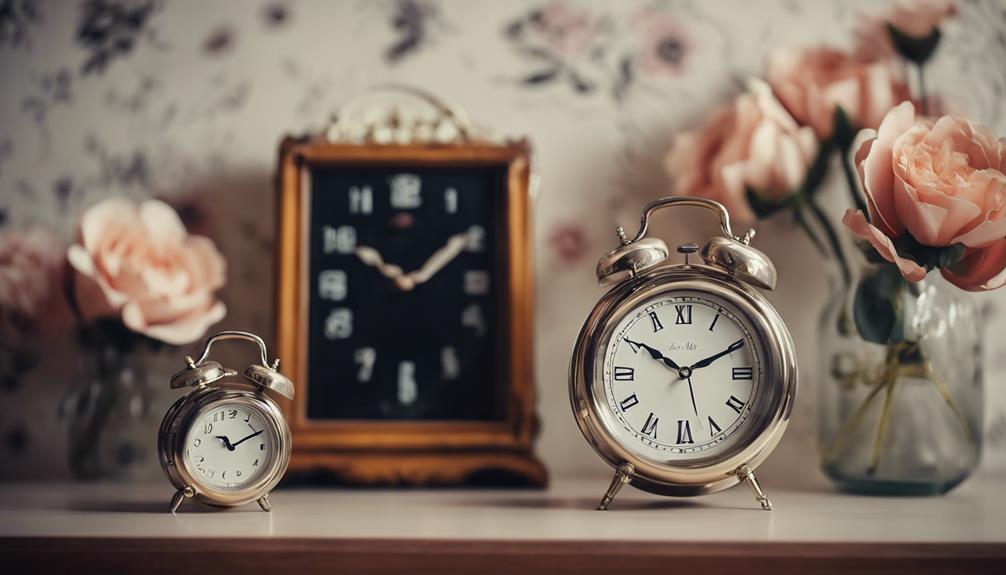
When you think about enhancing your space, consider how framed botanical wall art, geometric wall shelves, and sculptural wall planters can complement your aesthetic clock.
These decorative elements not only add character but also create a cohesive look that ties your room together.
Framed Botanical Wall Art
Framed botanical wall art brings a natural touch to your interior space, creating a calming and revitalizing atmosphere that enhances your decor. These decorative elements often showcase high-quality prints or original artwork that beautifully highlight the intricacies of plants and flowers.
Whether you prefer a sleek, modern design or a charming vintage style, framed botanical art serves as versatile additions that fit seamlessly into any theme.
Choosing pieces made with archival materials guarantees your art remains vibrant and lasts over time. This longevity allows you to enjoy your botanical displays without worrying about fading or deterioration.
By incorporating framed botanical wall art into your space, you create a cohesive look that elevates the overall aesthetic appeal of your room.
These artworks not only provide a connection to nature but also reflect your personal style, making your space feel uniquely yours.
Geometric Wall Shelf Display
Incorporating geometric wall shelves into your decor not only enhances the visual appeal of your space but also provides a stylish way to display your favorite items and plants. These aesthetic decorative elements add a modern touch, transforming plain walls into dynamic focal points. You can choose from various shapes like hexagons, triangles, and cubes, allowing for creative arrangements that suit your personal style and existing decor.
Made from materials such as wood, metal, or acrylic, geometric wall shelves introduce different textures that enrich your room's atmosphere. They're perfect for showcasing items like books, art pieces, or even small plants, bringing life to your walls and sparking conversation among guests.
Whether you place them in your living room, bedroom, or home office, these shelves balance style and functionality beautifully. Their unique designs not only serve as storage solutions but also act as striking design features that can elevate the overall aesthetic of your space.
With geometric wall shelves, you can effortlessly enhance your home with creativity and flair while ensuring your treasured items are on display for everyone to admire.
Sculptural Wall Planter Display
Sculptural wall planter displays bring together art and nature, allowing you to showcase your favorite plants in visually striking arrangements that elevate your decor. These innovative decorative elements serve as enchanting focal points, adding texture and greenery to your space. You'll find them in a variety of materials like metal, ceramic, and wood, enhancing their aesthetic appeal and fitting seamlessly into different interior styles.
The versatility of sculptural planters enables you to experiment with various plant types, including succulents, air plants, and trailing vines. This creative freedom lets you design unique arrangements that reflect your personality and taste. Many of these displays come with functional features, such as drainage systems or modular designs, which make maintenance a breeze while encouraging you to get imaginative with your plant placements.
Incorporating a sculptural wall planter display into your home not only beautifies your environment but also promotes a sense of tranquility and connection to nature. By integrating these eye-catching decorative elements, you're sure to impress everyone with your style and creativity.
Embrace the fusion of art and greenery, and watch your room transform into a serene oasis.
Flooring

When you're considering flooring, the choice can really shape the vibe of your space.
Polished concrete offers a sleek, modern elegance, while textured wood brings warmth and character.
If you're after timeless appeal, luxurious marble can elevate your room's aesthetic to a whole new level.
Polished Concrete for Modern Elegance
Polished concrete flooring transforms your space with its sleek, modern elegance while offering unmatched durability and low maintenance. This flooring option not only provides a smooth glossy finish but also reflects light, enhancing natural brightness and creating the illusion of a larger area. Imagine stepping into a room that feels both expansive and stylish!
One of the standout features of polished concrete is its incredible durability. When properly maintained, it can last over 30 years, making it a wise investment for any home. Plus, its low-maintenance nature means you'll only need to perform occasional cleaning and periodic resealing to keep it looking its best.
What truly sets polished concrete apart is its versatility. You can customize it to fit various aesthetic preferences and design themes, ensuring it complements your overall decor. Available in a range of styles and colors, it can easily adapt to your vision, whether you're aiming for industrial chic or modern minimalism.
With polished concrete, you get a flooring solution that marries function and beauty, making it a timeless addition to your home.
Textured Wood for Warmth
While polished concrete brings modern elegance to your space, textured wood flooring introduces a natural warmth and charm that instantly makes any room feel more inviting. The unique grain patterns and finishes of textured wood enhance the aesthetic appeal, allowing you to create a personalized and stylish environment tailored to your taste.
Available in various species like oak, maple, and walnut, textured wood offers distinct colors and characteristics that complement different decor styles. Whether you prefer a rustic vibe or a contemporary look, there's a textured wood option for you.
One of the standout features of textured wood flooring is its durability and resilience. With proper care and maintenance, it can last for decades, making it a smart investment for your home. Additionally, textured wood improves room acoustics by absorbing sound, which is especially beneficial in spaces where noise reduction is desired.
Incorporating textured wood into your home not only adds warmth but also elevates your overall decor, creating a cozy atmosphere that your family and guests will love. Choose textured wood for a timeless foundation that enhances both style and comfort.
Luxurious Marble for Timeless Appeal
Luxurious marble flooring offers an unrivaled elegance and durability that transforms any space into a sophisticated haven. As a timeless choice, it enhances the aesthetic appeal of your home, creating a stunning backdrop for your decor. The variety of colors and patterns available allows you to find the perfect style that suits your taste and complements your design vision.
One of the unique characteristics of luxurious marble is its natural veining, ensuring that no two floors are exactly alike. This adds a personalized touch to your interiors, making your space feel truly unique.
Beyond its beauty, marble's durability is one of its most appealing features. It's highly resistant to heat and scratches, making it ideal for high-traffic areas like kitchens while maintaining its elegant look over time.
To keep your marble flooring looking its best, regular maintenance is essential. Sealing and periodic polishing will preserve its luster and longevity, ensuring that this striking feature remains a focal point in your home.
With luxurious marble, you're investing in a flooring option that not only enhances your decor but also stands the test of time.
Conclusion
Incorporating aesthetic clocks into your room decor can truly elevate your space. They not only serve a practical purpose but also add a unique touch that'll impress everyone who walks in.
Remember, it's all about finding the right style that complements your existing fixtures and furniture. With the right lighting and decorative elements, your room will feel cohesive and inviting.
So go ahead, choose a clock that speaks to you, and watch your decor transform!
